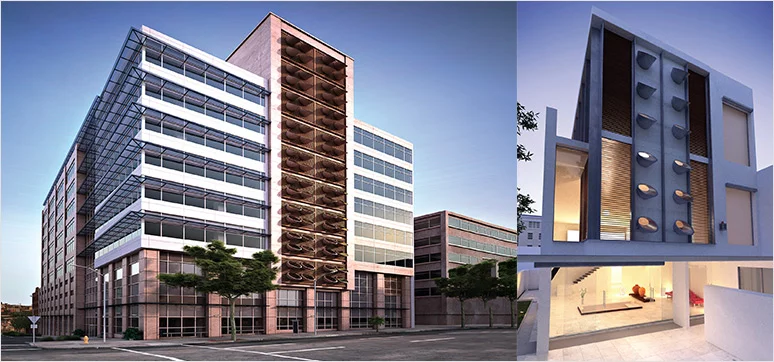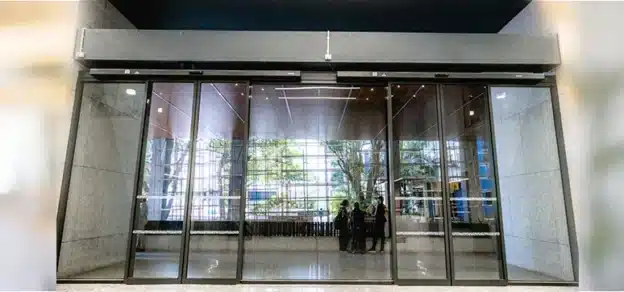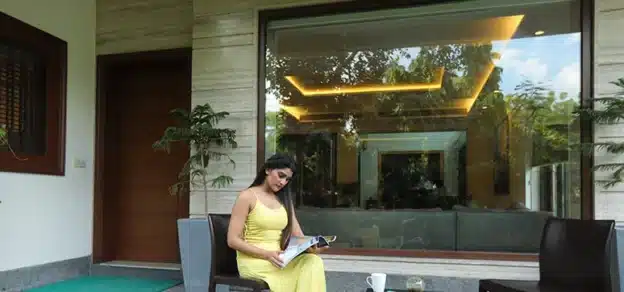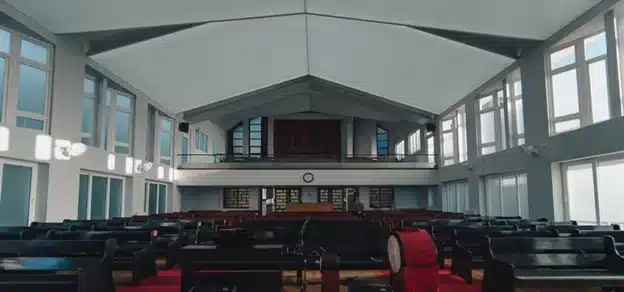Renewable sources of energy such as sunlight provide opportunities for conservation of energy in various geographic areas. This type of energy coming from natural resources provides environment friendly energy. As the amount of reserves of fossil fuel decreases, production cost of fossil energy increases. On the other hand, with increase in world population consumption of fossil fuel endangers the environment with increased pollution and contributes to global warming. Increase in the amount of greenhouse gases is causing climate change. Solar energy is one of the cheapest and most available renewable energies. However, only 0.23 percent of the total world energy consumption is produced using solar energy.Solar window technology allows the balanced achievement of thermal comfort by heating air with renewable solar energy. This window system can be considered one of the most affordable solar technologies.
Using solar radiation for heating the surface of an absorber, transferring the heat to the fluid interface (air), storing the thermal energy, and using the stored heat in the building when necessary describes the complete workings of the system. Collectors are actually part of the building and they can be installed as a window or skylight. In addition to heat generation, this system also provides interior lighting. But the amount of sunlight that reaches the interior space is reduced by about 30 percent due to space between the two glasses. In this project, we increased the efficiency of solar energy collection by appropriately dividing the lighting levels. The proposed solar window consists of different layers. They are explained in the following section.
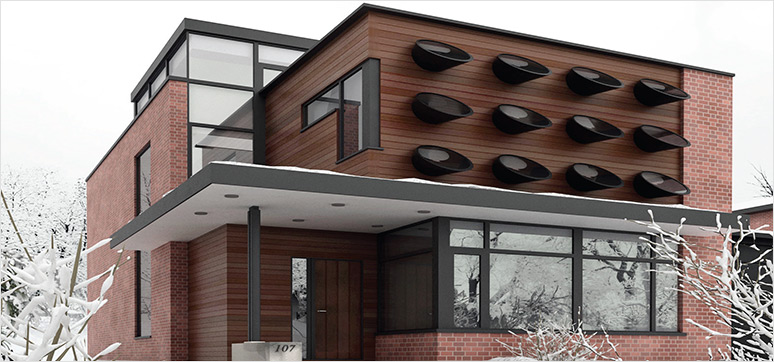
1) Glass (3 mm thick) with a Nano Coating: To achieve maximum energy absorption in solar collectors, the amount of light that passes through the glass must be increased by reducing the percentage of reflected light. Nano-technology has made it possible to achieve anti-reflection glass. It can be achieved by using a layer of anti-reflection (AR) coating composed of a very thin layer of silica with large pores. By using this method, we can improve the transparency of glass up to 98 percent and, in addition, the glass also has anti-static properties and the efficiency of the collector can be increased by as much as 15 percent.
2) Metallic, Energy-Absorbent Surfaces: For maximum solar thermal energy absorption and transfer to the air inside the container, a layer of metal can be used on the inside of the container. A dark metal surface is used in the system because the dark surface will be about 39°C warmer than a reflective white surface due to the absorption of solar energy. We used copper as an energy absorber in our system. To prevent the loss of the collected energy, the absorber plate is covered with a suitable insulation material.
Metal expands as its temperature increases, and this could cause damage to other components. To solve this problem, a gap was placed at the beginning and end of energy-absorbing, metallic surface. This gap separates the metallic surface from the glass and the steel frame. A flexible thermal insulator, such as a cork, is used to fill this gap.
Since metallic surfaces that absorb solar energy do not transfer the heat to the concrete surface, insulation can be used between them to prevent the loss of heat energy.
3) Concrete Container to Collect Hot Air: The container is made of concrete that was prefabricated in a factory. In the prefabrication stage, a metallic absorber is placed in the interior part of the container. The air inside the container is heated by the metallic absorber. When a substance is heated, it expands and its density decreases. Light air is transferred through the tube to the next container.
4) Cold Air Transmission Pipe: Due to the higher density of cold air, it is always located in the lower layers of the air. By putting the pipe at the bottom of the system, the cold air from the room is absorbed into the system through a suction caused by the warm air in the container. The PVC transmission pipes are covered with insulation and transfer the heated air from the absorber container to the thermal storage container.
5) The External Layer of the Storage: The storage tank is composed of two layers. The outer layer makes the rotation of the hot injected air easier, and the second layer keeps the gravel in the tank. The outer layer is made of PVC with an exterior layer of insulation. It is used to collect the air that has been heated by the absorbers and transfer it to the central storage tank.
6) Control Key: When there is no need to provide hot air to the interior space, this key can be turned to block the entrance space of cold air into the system, thereby stopping air circulation in the system.
7) The Way Hot Air Enters the Storage Tank: The reason for placing the entrance part of the warm air at the bottom of storage tank is that the heating process will be slow if we put it in the line of the last absorber container. This is because of the low density of warm air and the higher density of cold air, which would allow the input warm air to remain in the upper part of the tank and the cold air at the bottom. By placing the entrance part of the air in the lower section, we can improve the air circulation. The warm air that enters the bottom of the tank warms the gravels and mixes with the cold air as it moves toward the top of the tank. To create suction over the entire system, we used a small fan to make it easier to mix the hot air in the whole system. This fan acts based on the specific timing, which can be adjusted based on temperature of the air. At the indoor space, usually unpleasant airborne dust, toxic chemical fumes, harmful gases, microbes, viruses, and allergens, cause pollution and reduce the air quality levels.
In this window system, the next step after the fan is a filter that is used as an air purifier. The air is blown through the membrane filter by the fan, trapping the large contaminant particles. The membrane can be made of cotton, foam, fiberglass, or other synthetic fibers. For this membrane, an efficient barrier filter was used that has the ability to prevent the passing of 99.97 per cent of the pollutant particles larger than 0.3 micron. However, nanotechnology has played a significant role in the quality and efficiency of filters.
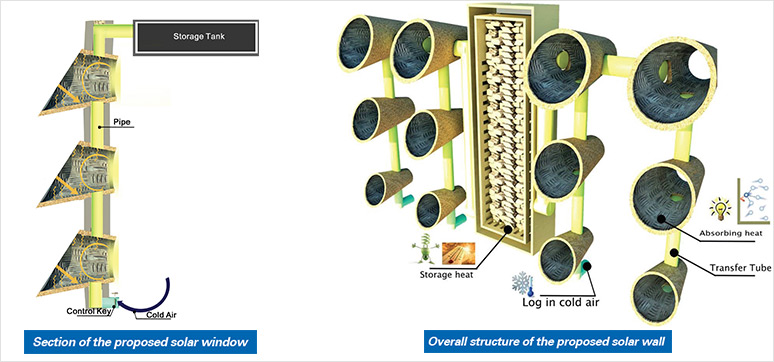
The proposed solar window can be a kind of innovation in providing pleasant hot air for the building to increase thermal comfort of the occupants and reduce the use of non-renewable resources, such as fossil fuels. Optimum usage of solar energy will reduce the emissions of greenhouse gases and help reduce the rate of stratospheric ozone depletion over time.
The proposed solar window has the following benefits:
- This window system is based on two aspects of light and heat and has led to combining them.
- A large portion of this window system is prefabricated in a factory, and so, by observing and measuring components, the problems that occur will be diminished.
- This product will prevent air pollution caused by the use of fossil fuels by producing pleasant hot air with natural renewable energy. It will help families financially and its resource conservation aspects will lead to the enhancement of the national economy.
- The system can be used as a space heating system in impassable and deprived areas.
- The window system is part of the building and does not occupy additional space; also it does not require a lot of space for its installation.
- Due to its simple structure, the system can be built with little cost and used immediately.
- In the United States, air conditioning systems use more than 25 percent of the energy in commercial buildings and almost half of the energy in residential buildings. The proposed system, with its ability to heat, circulate, and filter air, can be used to eliminate a significant portion of this energy usage.
- By changing the structure of the window system, it can eliminate the need for metallic guards on the windows of houses for security purposes.
- This system has a balanced division of openings in the whole wall that allows light to reach all of the enclosed space without being so bright that it is uncomfortable for the occupants.
- The two layers of glass used in the system and the space between them minimize heat and noise transfer from outside to inside or vice versa and provide thermal and sound insulation.
